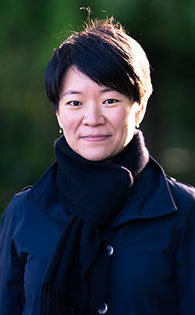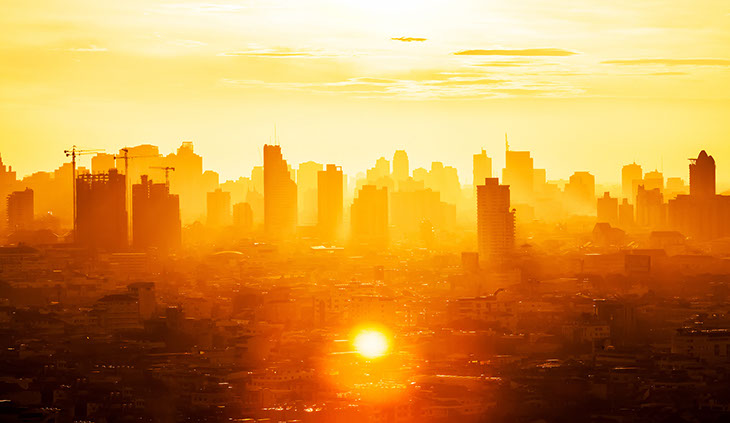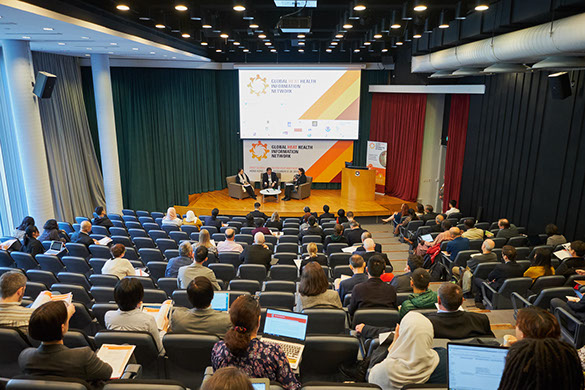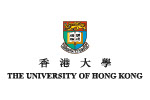summertime, and
the living is deadly
Heat is killing people in cities. The world’s first international forum devoted to heat and health was held at HKU in late 2018, and scientists from around the globe have launched an initiative to reduce the deadly impact of heatwaves and rising city temperatures.
In some areas, heatwaves kill more people than any other natural phenomenon. In Hong Kong, this most densely populated of urban sprawls, recent research has shown that every 1 degree Celsius increase in maximum daytime temperature above 28.2 degrees Celsius results in a 1.8 per cent increase in mortality. Furthermore, experts note that the world could reach a level of more than 80 to 90 per cent urbanisation by the last quarter of the century, meaning large populations will be at risk.
Statistics like these have brought issues with city heat to the public eye. “Urban climate is an emerging research field,” said Dr Ren Chao, Associate Professor in the Faculty of Architecture, and prime mover in setting up the First Global Forum on Heat and Health in December 2018, which was supported by the joint office of World Meteorological Organization and the World Health Organization.
“Often heat and health studies focus on the outside temperature only, but people die inside. We are linking outside and inside, and setting out to engage the community in our research. Hong Kong is ahead in this field – we know how to manage the physical setting of a crowded city via design and planning, so others are looking to learn from us.”
Her research concentrates on climatic applications in urban planning, as well as sustainable urban design. She has worked in China, Taiwan, Singapore, the Netherlands and France in this field and over the past 10 years has helped the government with guidelines on urban climatic application.
“It is interesting that at present there is no official heatwave definition in Hong Kong, only hot weather warnings, and there is little public awareness about the problem,” she said. “That is not limited to this city though – the impact of rising global temperatures onthe built environment is still being overlooked in most parts of the world.”
Dr Ren revealed her findings at an American Meteorological Conference in Seattle in 2017, and was surprised to find she was unique on the Heat and Health network as the only delegate with a background in town planning and architecture. She expects that to change soon, as the importance of urban design as long-term action on heat-health becomes better known.
“Talking with delegates there, we discussed the need to go back to the fundamentals and build a better quality living environment to help alleviate the effects of urban heat,” she said. “We also need to rethink urban planning.”
It was those discussions and a realisation of the extent of the problem that sparked the idea for a heat and health conference to be held in Hong Kong. It was attended by 120 climate and health experts from 33 countries, who pledged to build the capacity of governments, organisations and professionals to protect populations from the avoidable risks of extreme and ambient heat.
Within Hong Kong, Dr Ren hopes her research will benefit policy change. “Hong Kong is a high-density urban environment, an artificial environment. We local researchers have been working with the Planning Department to build up an Urban Climate Map for the city. The Government needs a comprehensive picture of urban climate conditions in places that are already developed and those where there are major development projects.
“There are plans afoot to build mega developments, including the East Lantau Metropolis, which will house more than a million people, and the Greater Bay Area, a massive scheme by the Chinese Government to link the cities of Hong Kong, Macau, Guangzhou, Shenzhen, Zhuhai, Foshan, Zhongshan, Dongguan, Huizhou, Jiangmen and Zhaoqing into an integrated economic and business hub. Proper planning to ensure a healthy urban climate in the near future will be crucial.”
Heat-health warning system
Her team has also initiated a collaboration with the Hong Kong Observatory to develop and promote a heat-health warning system.
The current problem with urban heat in Hong Kong is exacerbated, in some cases, by local beliefs.
Dr Ren said: “Some older people believe night-time temperature is naturally lower. This is simply not true – the way Hong Kong’s city climate is going now, there could be a time when we will have no real winter, only summer here. Also, they won’t turn on a fan or air-conditioner because traditional Chinese medicine says machines are not good for your health.”
On the positive side, the Government is now aware of the problem: the Research Council has granted HK$6.7 million in funding over the next three years, and local researchers from four universities have been teamed up to work together. The HKU team will be cross-disciplinary, spanning the Engineering Building Department and Faculty of Architecture,as well as partnering with the Hong Kong Planning Department, the Observatory and several NGOs.

![]() Often heat and health studies focus on
Often heat and health studies focus on
the outside temperature only, but people die inside. We are linking outside and inside,
and setting out to engage the community
in our research. Hong Kong is ahead in
this field – we know how to manage the physical setting of a crowded city via
design and planning, so others are looking
to learn from us. ![]()
Dr Ren Chao

The First Global Forum on Heat and Health held at HKU in December 2018 brought together over 120 climate and health experts from 33 countries to strengthen cooperation in science.

Next
Back
Home
May 2019
Volume 20
No. 2

Research
